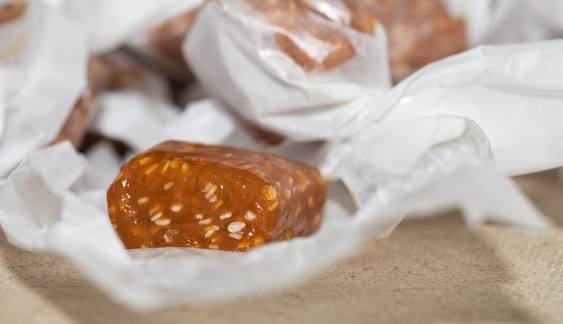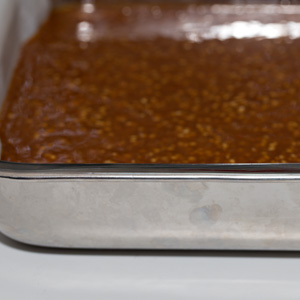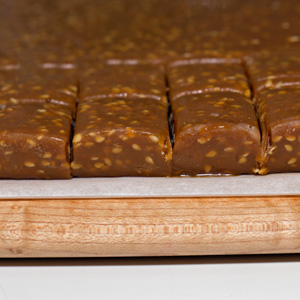Benne and Sorghum Caramels

introduction
Shrilly operatic on its own, sorghum softens palpably when cream or butter coax it into hushed civil tones. The recipe below offers plenty of modulation in the way of dairy—so carried away did we become with the cream-and-butter show at one point that we actually had to ease up. The results are a soft, chewy candy that hits sorghum’s high notes perfectly, then drops into the deep warm registers of brown sugar and butter. Why do we put up with sorghum to begin with? Because great sorghum has a flavor profile that rivals the complexity of fine wine. In culinary applications, sorghum is more dynamic than maple syrup and more refined than molasses. Agriculturally speaking, sorghum scores high points in crop rotation and soil improvement.
These candies are not, properly speaking, caramels. No white sugar is cooked to glassy mahogany on their watch. Yet they satisfy with the yielding chewiness and dark, plummy richness that makes caramels irresistible. Call their name designation the author’s prerogative.
Cooking Remarks
Anson Mills grows heirloom sorghum and processes it into small-batch syrup for research chefs, but our sorghum is not yet available at retail. A handful of small growers do the same, some on an artisan level. But for quality and consistency across the board, nothing surpasses Muddy Pond Sorghum Mill out of Tennessee. They’ll be thrilled to sell you some.
Candy is a tricky balance of ingredient ratios and temperature. This is one reason we never make it. Another is the fact that candy represents an addiction for anyone from Indiana. Anyone like Kay.
A couple of things to note: The ingredients fly into a rage as soon as they come to a boil, which is why we advise you to use such a BIG pot. There’s nothing worse than scrubbing candy off a hot stove—except scrubbing it off a cold stove.
As the mixture cooks, it settles into a sultry, hip, rolling simmer. It will take longer to climb the final 10 degrees than the first 235. You need to take it to the firm-ball stage—that is, between 248 and 252 degrees. Temperatures north of 255 will prime the finished candy to end up with a greasy mouthfeel. The candy also takes its sweet time setting up—give it at least 3 hours in the fridge.
equipment mise en place
For this recipe, you will need parchment paper, an 8-inch square baking pan, a 4- or 5-quart heavy-bottomed Dutch oven (preferably enameled cast-iron, such as Le Creuset or Staub), a silicone spatula or wooden spoon, a whisk, a digital instant-read thermometer or a candy thermometer, a wire rack, aluminum foil, a small offset spatula, a cutting board, a ruler, a paring knife, a chef’s knife, and twisting wax paper.
-
-
7ounces (14 tablespoons) unsalted European-style butter, plus additional for greasing the pan and parchment paper
-
8ounces (1 cup plus 2½ tablespoons, packed) light brown sugar
-
10.2ounces (scant ¾ cup) Muddy Pond sorghum
-
10ounces (1¼ cups) heavy cream
-
3.3ounces (½ cup plus 2 tablespoons) Anson Mills Sea Island Benne Seeds, frozen
-
-
Cut a sheet of parchment paper to measure 6¾ wide by 16½ inches long. Butter an 8-inch square baking pan. Line the pan with the parchment paper so that the ends extend equally on opposite sides of the pan (fig. 1.1). Lightly butter the parchment.
-
In a 4- or 5-quart heavy-bottomed Dutch oven (preferably enameled cast iron, such as Le Creuset or Staub), melt the butter over medium-low heat. Add the brown sugar, sorghum, and cream and whisk to combine. Bring the mixture to a boil and cook over medium-high heat, stirring frequently with a silicone spatula or wooden spoon, until the mixture thickens (fig. 2.1), and registers 235 degrees (soft-ball stage) on an instant-read thermometer, about 15 minutes. Reduce the heat to low and continue to cook until the mixture reaches 248 to 250 degrees. Immediately remove the pot from the heat, whisk vigorously for 10 seconds to cool the caramel, and then stir in the frozen benne seeds (fig. 2.2). Pour the caramel into the prepared pan (fig. 2.3), tilt the pan to evenly distribute the candy lava evenly, and place the pan on a wire rack. Let the caramel repose until the bottom of the pan is cool, about 3 hours. Tightly cover the pan with aluminum foil and refrigerate until the caramel is cold and firm, at least 3 hours or up to overnight.
-
Free the chilled caramel from the unlined sides of the pan by inserting a small offset spatula between the candy and pan’s edge, pressing the blade against the pan while sliding the spatula down the length of each side (fig. 3.1). Repeat the process, this time pressing edge of the caramel toward the center of the pan, and then slide the spatula along the side to ensure that candy is not sticking to the pan. Lay a sheet of parchment paper on a cutting board and with the parchment tails on the outside of the pan (not covering the caramel), invert the pan on top. Use the parchment tails to help free the block of caramel from the pan, allowing it to fall onto the board. (If the caramel is disinclined to free itself, throw a damp, hot kitchen towel over the pan top for 10 to 15 seconds, and then lift the pan away.) Peel the parchment off the caramel, and then lay it back on top. Flip the block, sandwiched between the parchment sheets, so that it is right side up and remove the parchment that is now on top (fig. 3.2). Using a ruler and a paring knife, notch the caramel at ¾-inch intervals along two adjacent sides. With a chef’s knife, cut the caramel into ¾-inch pieces using the notches as guides (fig. 3.3). Wrap each piece in twisting wax paper. Stored in an airtight container in the refrigerator, the caramels will keep indefinitely, but prospects for their long-tem survival are not good.
-
-
1.1

-
-
-
2.1

-
2.2

-
2.3

-
-
-
3.1

-
3.2

-
3.3

-